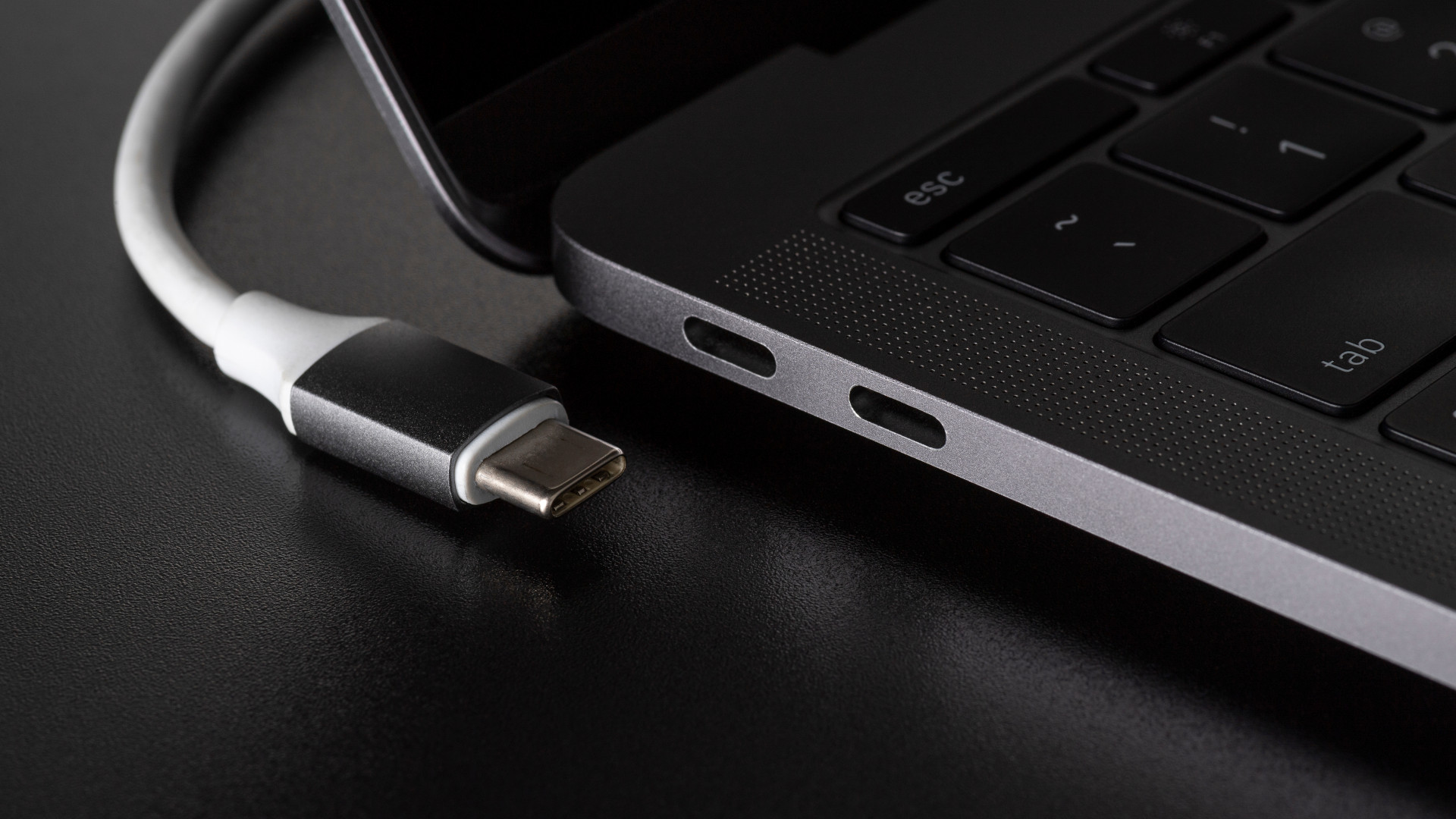Thunderbolt vs USB: Which is the best port?
We pit Thunderbolt vs USB to see which is the best port for the job

USB ports have become incredibly important to both desktop PCs and laptops, being used for charging, data transfers, connecting monitors and devices, and more. However, not all ports are built the same.
While USB ports and Thunderbolt ports do share plenty of similarities, there are key differences that could end up influencing your hardware buying decision. But which one should you focus on more when buying a PC?
In this article, we'll break down what each type of port does as well as their benefits and drawbacks to help you make an informed buying decision, whether you're looking to purchase one of the best laptops, best desktops PCs, or simply want to better understand the specs for a device you already have.
So read on to find out all about Thunderbolt vs USB ports and cables.
Thunderbolt vs USB: What is USB?

USB (or Universal Serial Bus) is an electronics industry communication standard that allows different devices to talk to each other.
It is an open standard, which means anyone can implement it in their products so long as they meet specific technical requirements, and as such it has become the de facto way for peripherals and devices to connect to each other. Also, it's increasingly becoming the default charging method for a wide range of products from laptops to smart home devices.
Starting with USB Gen 3.1, USB can come with the Type-C connector, which is a wide, flat, and versatile interface that makes connecting devices almost as easy as a 3.5mm headphone jack - and the latest generation of USB, USB4, will only have Type-C connectors. Previous generations of USB might still feature older Type-A and Type-B connectors, but those are quickly aging out of the market.
Sign up for breaking news, reviews, opinion, top tech deals, and more.
Thunderbolt vs USB: What is Thunderbolt?

Thunderbolt is similar to USB in terms of function, but it only just recently became compatible with USB Type-C.
Developed and owned by Intel and introduced by Apple for the MacBook Pro in 2011, Thunderbolt is a data communications standard that grew out of the early Mini DisplayPort standard for video and audio signals to include support for power and data transfer alongside A/V.
The first couple of generations of Thunderbolt used a Mini DisplayPort connector, but starting with the third-generation standard, Thunderbolt uses the same Type-C connector as the updated USB standard.
Also starting with Thunderbolt 3, Thunderbolt is compatible with any USB Type-C device.
Thunderbolt vs USB: Interoperability
While Thunderbolt and USB Type-C are now compatible with each other, there are quirks as to how they interface with each other.
To take advantage of Thunderbolt speeds, display and peripheral support, and charging capability, both connected devices will need to have a Thunderbolt port, with a compatible Thunderbolt cable to connect the two.
Using a Thunderbolt 4 cable, for example, won't give you the faster speeds promised by that standard if you plug it into a Thunderbolt 3 port or USB-C Gen 3.2 port, and connecting two Thunderbolt 4 ports with a USB-C Gen 3.1 cable will likewise throttle the connection to the slowest common standard in the chain, which is USB-C Gen 3.1.
That said, Thunderbolt 3 and 4 ports and cables are compatible with USB-C ports and cables, so you can use them together just fine, but the maximum connection speed will be limited to the slowest standard involved.
It means that no matter what you pick, you can always use older tech with these newer (though more expensive) cable types and vice versa. However, to take full advantage of the latest Thunderbolt or USB technology, you'll need to make sure you're connecting two like ports (so Thunderbolt 3-to-Thunderbolt 3 or USB4-to-USB4) with a cable that matches the standard of the two connected ports, otherwise you're going to have an inconsistent experience.
Thunderbolt vs USB: Data transfer & charging

The latest USB-C connections (USB4) can transmit data between devices at speeds of up to 40Gbps (the exact ceiling depends on the port's specific USB SuperSpeed rating) and can deliver nearly 100W of power to charge your phone, tablet, or laptop battery (with a minimum of 7.5W power transfer required by the standard).
Thunderbolt 4 transfers data at up to 40Gbps, which is four times as fast as the first-gen Thunderbolt standard, and double what Thunderbolt 3 was capable of (20Gbps). The supported PCI Express data rate is also as high as 32Gbps, which is fast enough to use an external GPU with an Ultrabook for high-end gaming or content creation.
Take things further to Thunderbolt 5, which has been announced but has yet to fully make its way to market, and you're looking at even faster data transfer rates of up to 80Gbps, or up to 120Gbps in one direction (like output to a single monitor).
In terms of power delivery, Thunderbolt 5 will be able to support up to 240W, with a minimum required delivery of 140W, making it ideal for fast-charging beefy devices like laptops.
In this regard, Thunderbolt is the clear winner between the two standards as it generally offers faster transfer and charging speeds than USB-C, as well as longer cables without sacrificing speed. That makes Thunderbolt perfect for backing up data to external hard drives, transferring data between devices, and very quickly charging devices.
Thunderbolt vs USB: Linking monitors & devices

The latest USB and Thunderbolt standards are capable of connecting monitors and devices between each other and to PCs, but the type of connection also determines what devices (and how many) can be connected.
USB-C Gen3.2 and USB4 support DisplayPort A/V signals for connecting your device to a USB-C monitor, but USB-C Gen 3.1 does not. USB4 can support up to 8K video at 60Hz, but it cannot support daisy-chaining devices (where you can connect multiple devices along a chain, including one or more monitors, using only one device port).
Meanwhile, a single Thunderbolt 4 cable can transmit a video signal for two 4K monitors at 60Hz or one 8K monitor at 60Hz.
With the recently announced Thunderbolt 5 standard, both Thunderbolt 5 and USB4 will be able to support up to a single 16K display, while Thunderbolt 5 will be able to support two 8K monitors at 60Hz or up to three 4K monitors at 144Hz.
Thunderbolt 5 will also be able to push a refresh rate of up to 540Hz at lower resolutions, making it ideal for gaming monitors.
Thunderbolt vs USB: Security

Security is surprisingly important when it comes to port and cable types, as malware and viruses can easily spread between connections. So when it comes to security, both port types have this in spades.
USB got a major upgrade back in 2019 with a cryptographic-based 128-bit authentication system that helps defend against non-compliant USB chargers, USB sticks laden with malware, and other assorted dangers.
Thunderbolt 4, meanwhile, features Direct Memory Access (DMA) protection, enhancing the security against potential threats by preventing unauthorized memory access.
In this particular area, both standards have security measures to protect your data and your devices from threats. Thunderbolt may be more advanced in this regard, but USB is still quite reliable, so you can choose either and be well-protected - though don't rely on a USB standard as your sole security solution. Make sure you have antivirus protection on your devices as well.
Thunderbolt vs USB: Which to choose?

Overall, Thunderbolt ports and cables win out as the type we recommend. It outperforms standard USB in nearly every area, all while maintaining backward compatibility with the latter so you can still use your older devices.
However, USB is still pretty much universally beloved and compatible with almost every device. Also, Thunderbolt technology is owned by Intel, so device manufacturers must license it for use in their products, which increases the final cost for the user.
USB, meanwhile, is an open standard, so anyone can implement it in their products, generally making USB cheaper to use. And its specs are still impressive, not falling too far behind Thunderbolt, so in terms of a budget-friendly option, this is the way to go.
Ultimately, however, only the most demanding user is going to fully utilize all of the features that make Thunderbolt great. For most people, the more prevalent USB ports and cables are going to be more than enough for their needs, and in rare cases where you have a choice, going with USB is one way to help keep within your budget.

Named by the CTA as a CES 2023 Media Trailblazer, Allisa is a Computing Staff Writer who covers breaking news and rumors in the computing industry, as well as reviews, hands-on previews, featured articles, and the latest deals and trends. In her spare time you can find her chatting it up on her two podcasts, Megaten Marathon and Combo Chain, as well as playing any JRPGs she can get her hands on.
- John LoefflerComponents Editor